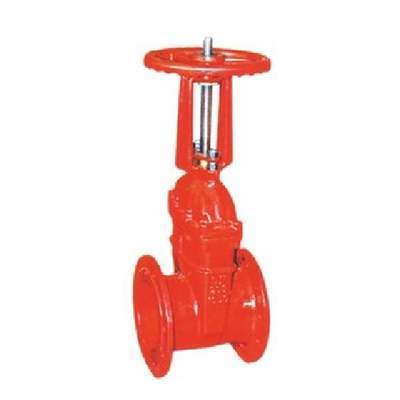Introduction

Fire fighting valves are the unsung heroes of fire protection systems. These specialized valves, strategically placed throughout a building or facility, regulate the flow of water or other extinguishing agents. By doing so, they enable firefighters to rapidly and effectively combat fires, minimizing property damage and saving lives. A comprehensive understanding of fire fighting valves is crucial for ensuring the optimal performance of your fire protection system.
Types of Fire Fighting Valves: A Closer Look
Fire fighting valves come in a diverse range of types, each tailored to specific applications. Some of the most common types include:
- Gate Valves: These valves, characterized by a sliding gate that opens and closes to control flow, are widely used for stopping and starting the flow of water or other fluids. They are ideal for applications where precise flow regulation is not required.
- Globe Valves: Globe valves employ a disc-shaped plug that moves up and down to regulate flow. They are often used for throttling, allowing for fine control of fluid flow rates.
- Check Valves: These valves, as the name suggests, prevent the backflow of fluids. They are essential in fire protection systems to ensure that water flows in the correct direction.
- Ball Valves: Ball valves utilize a spherical ball with a hole through its center to control flow. They offer quick on/off control and are commonly used in fire sprinkler systems.
- Butterfly Valves: Butterfly valves feature a disc-shaped plate that rotates to regulate flow. They are compact, lightweight, and suitable for large-diameter piping systems.
- Hydrant Valves: Hydrant valves control the flow of water to fire hydrants, providing a convenient and accessible water source for firefighters.
- Alarm Valves: Alarm valves are designed to activate alarms when a fire sprinkler system is activated, alerting occupants to the presence of a fire.
The Mechanics Behind Fire Fighting Valves
Fire fighting valves operate on relatively simple mechanical principles. When a fire is detected by a fire alarm system or a heat-sensitive device, a signal is transmitted to a control panel. This signal, in turn, triggers the activation of the appropriate valves. As a result, the extinguishing agent, typically water, is released and directed towards the fire’s location.
The Vital Importance of Regular Inspection and Maintenance
Regular inspection and maintenance of fire fighting valves are paramount to ensure their optimal performance and reliability. A well-maintained fire protection system can significantly enhance the safety of a building or facility. The key benefits of regular maintenance include:
- Early Detection of Issues: Regular inspections can identify potential problems, such as leaks or corrosion, at an early stage, allowing for timely repairs and preventing costly system failures.
- Prevention of System Failures: By addressing issues proactively, maintenance helps to prevent system failures that could compromise the building’s fire safety.
- Compliance with Fire Safety Regulations: Regular maintenance ensures that the fire protection system complies with relevant fire safety codes and standards, reducing the risk of penalties and legal liabilities.
Factors Influencing Fire Fighting Valve Performance
Several factors can impact the performance of fire fighting valves:
- Water Pressure: Insufficient water pressure can hinder the effectiveness of a fire protection system. Adequate water pressure is essential to ensure that the valves can operate correctly and deliver the necessary flow rate of water.
- Valve Size: The size of the valve must be appropriate for the size of the pipe and the required flow rate. A valve that is too small can restrict flow, while a valve that is too large may not provide adequate control.
- Material: The material of the valve should be resistant to corrosion and other environmental factors. Stainless steel and brass are common materials used in fire fighting valves due to their durability and corrosion resistance.
Designing a Robust Fire Fighting Valve System
The design of a fire fighting valve system is a complex process that requires careful consideration of several factors:
- Building Layout: The layout of the building will dictate the optimal placement of valves and the routing of piping.
- Occupancy: The type of occupancy, such as residential, commercial, or industrial, will influence the specific fire protection requirements.
- Fire Hazards: The presence of specific fire hazards, such as flammable liquids or combustible materials, will determine the type and number of valves needed.
Common Fire Fighting Valve Applications

| Valve Type | Common Applications |
|---|---|
| Gate valve | Main water supply lines, branch lines, and isolation valves |
| Globe valve | Flow control, throttling, and pressure regulation |
| Check valve | Preventing backflow in piping systems |
| Ball valve | Quick on/off control, isolation, and mixing applications |
| Butterfly valve | Large-diameter piping systems, HVAC systems, and industrial processes |
| Hydrant valve | Controlling water flow to fire hydrants |
| Alarm valve | Activating alarms in sprinkler systems |
Conclusion
Fire fighting valves are indispensable components of modern fire protection systems. By understanding the different types of valves, their functions, and the importance of regular maintenance, you can significantly enhance the safety of your building or facility. For more in-depth information and tailored solutions, consult with a qualified fire protection engineer.
FAQ
How often should fire fighting valves be inspected?
Fire fighting valves should be inspected annually by a qualified technician.
What are the signs of a faulty fire fighting valve?
Signs of a faulty valve include leaks, difficulty in operation, and unusual noises.
What is the difference between a wet and dry barrel fire sprinkler system?
Wet pipe systems have water in the pipes, while dry pipe systems have air or nitrogen.
How do I select the right fire fighting valve for my application?
Consult with a fire protection engineer to determine the appropriate valve type and size for your specific needs.
